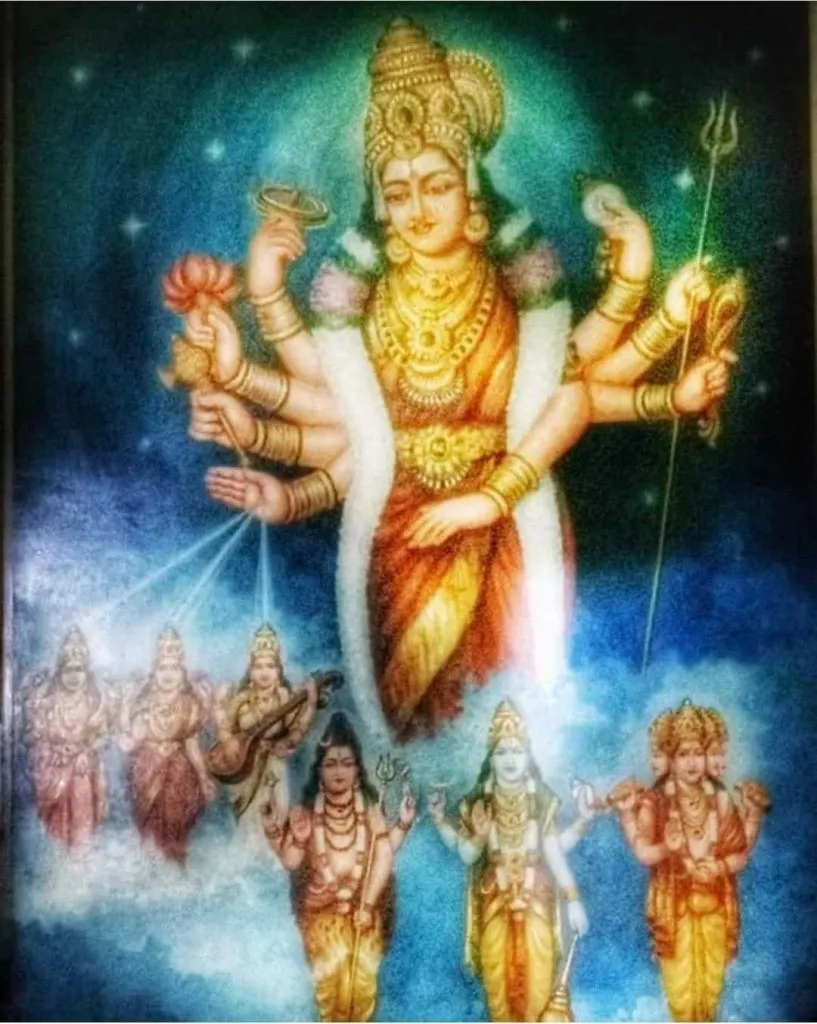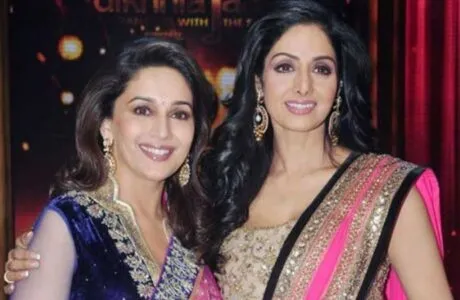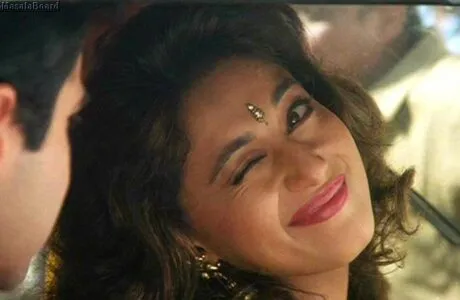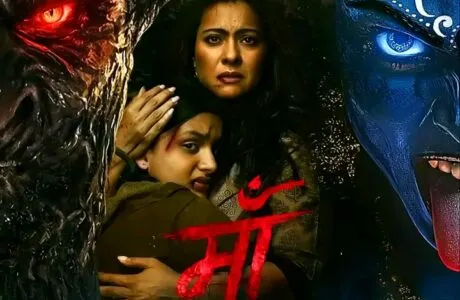
Adi Parashakti: From Formless Eternity to Manifest Divinity
In the vast spiritual expanse of Hindu philosophy, Adi Parashakti is the eternal, infinite, and formless Supreme Energy — the root cause of creation (Srishti), preservation (Sthiti), and destruction (Samhara). In her Nirguna (formless, attribute-less) aspect, she pervades the cosmos beyond time, space, and matter. Yet, when cosmic balance demands or a devotee’s pure devotion calls, she manifests in her Saguna (with form and attributes) aspect.
Adi Parashakti – From Nirgun to Sagun Swaroop “Paramba”!
In the infinite realm of spirituality, the Nirgun Nirakar Brahman – the formless, attribute-less absolute – stands as the highest truth. This supreme consciousness, also called SatChitAnand or Para Brahman, manifests in three eternal aspects:
- Sat (Existence) as Sadashiva (Divine Zero) – the embodiment of pure being and stability.
- Chit (Consciousness) as Adi Parashakti (Divine Infinity)– the primal creative energy, the Mother of all.
- Anand (Bliss) as Param Krishna (Divine Buffer)– the eternal enjoyer, the source of divine love and joy.
Let’s discuss in detail!
In the beginning, beyond time, form, and attributes, exists Adi Parashakti in her Nirgun (formless) state — the infinite, unmanifested divine energy, beyond all dualities. Adi Parashakti is one of the Three Supreme Personalities of Godhead presiding over the Anant Koti Brahmandas (infinite universes), alongside Param Krishna and Maha Sadashiva. Each represents a fundamental divine principle:
Param Krishna embodies Aatam Tatva (Anand or Bliss), the eternal joy that preserves and stores the essence of creation.
Maha Sadashiva embodies Shoonya (the Divine Zero), also called Sat Tatva or Shiva Tatva, representing stillness and pure consciousness without activity.
Adi Parashakti embodies Infinity (Shakti / Chit Tatva), the boundless energy that activates and sustains all processes.
In her Nirguna (formless, attribute-less) aspect, she pervades the cosmos beyond time, space, and matter. Yet, when cosmic balance demands or a devotee’s pure devotion calls, she manifests in her Saguna (with form and attributes) aspect.
In this manifested form, she is revered as Paramba — the Primordial Mother of all existence. Paramba is worshipped as Durga, Uma, Ambika, and Purna Devi.
Let’s Discuss how she does it.
Adi Parashakti is the source from which all universes, deities, and energies originate. She is formless in essence but assumes countless forms for cosmic balance. In her infinite compassion, she divides her supreme power into three primary energies:
- Vidya Shakti – The Spiritual chord of wisdom and spiritual awakening.
- Prakriti Shakti – The creative and sustaining nature of the universe.
- Maya Shakti – The power of illusion and material manifestation.
Vidya Shakti – Adi Parashakti in her Spiritual Form
In the eternal play of the cosmos, Vidya Shakti represents the supreme force of divine intelligence.
It operates in two distinct yet interconnected ways:
- The Path to Shanti — leading the seeker towards peace, Nirvana, and Moksha.
- The Path to Shakti — granting powers in the form of Riddhi (prosperity), Siddhi (spiritual mastery), Nidhi (treasures), Sthiti (sustenance), Srishti (creation), and Sanghaar (destruction).
These two currents of wisdom are channelled through Brahman Shakti and Shree Shakti — symbolised by Maa Adya Kali and Maa Maha Lalitambika.
1. Adya Kali — The Brahman Shakti (Brahman Vidya)
Maa Adya Kali is the ultimate liberator, guiding the soul beyond the illusions of time, desire, and fear.
She bestows Salvation through five divine gateways:
- Kali — Mastery over Kaal (Time) and its every dimension.
- Tara — Supreme wisdom of Yog and Nirvana, leading to liberation.
- Chhinnamasta — Victory over the five inner demons (Kaam, Krodh, Lobh, Moh, Ahankara), freeing the mind from stress and bondage.
- Bhairavi — Awakening of Kundalini Shakti and liberation from all fear.
- Dhumavati — Dissolution of desires (Iccha) and impurities (Vikar), bringing the bliss of detachment (Vairagya).
2. Maha Lalitambika — The Shree Shakti
If Adya Kali grants liberation, Maha Lalitambika grants the power to transform.
She empowers the devotee through five celestial blessings:
- Lalita Tripura Sundari — Bestows youthfulness, mastery over the 16 arts and 64 sciences, and soul-fulfilling bliss leading to Moksha.
- Bhuvaneshwari — Grants authority, Siddhi, Nidhi, and control over the mechanisms of the cosmos.
- Baglamukhi — Endows the power to command all forms of Vak (communication) — audible, inaudible, and spiritual — to attract and manifest anything in creation.
- Matangi — Brings knowledge, inspiration, and the removal of obstacles, ensuring a smooth flow in all endeavours.
- Kamalatmika — Grants abundance in all forms of wealth and resources to accomplish divine and worldly tasks.
Together, the ten goddesses — the Mahavidyas — embody the complete spectrum of divine intelligence, from the stillness of Moksha to the dynamic powers of transformation.
The Concept of Prakriti Shakti
Maa Bhuvaneshwari is the cosmic architect — the one who shapes and sustains the Brahmanda (cosmos). She creates infinite universes (loka) that reside within Universal Beings, like cells in an eternal body.
These cosmic cells give rise to hormonal forces, which in turn generate attributes (Guna). From these Gunas emerges Nature (Prakriti), the living blueprint of existence.
The universe is like a boundless field, and its farmer is none other than Lord Krishna.
Just as a farmer cultivates the land to yield life, the cosmic field yields Param Prakriti — the Supreme Nature — which flows into five Principal Prakritis:
1. Durga — The Mula Prakriti of Time, Temperature, and Current
The primal nature (Mula Prakriti) of Kaal (Time), Mahesh (Temperature/Stillness — Shiva), and Rudra (Current/Movement) manifests as Maa Durga.
She is the Buddhi (Intelligence) of the universe, harmonising the forces of change and stability.
2. Saraswati — The Mula Prakriti of Positioning (Brahma)
The primal nature of the Positioning Agent — Brahma — is Communication and Sound.
This is embodied by Maa Saraswati, the eternal flow of Shabda Brahman, who places every element of creation in its rightful order.
3. Lakshmi — The Mula Prakriti of Sustenance (Mass Field)
The primal nature of the Sustaining Agent, the great Storer of energy and matter, is Light and Purpose.
Maa Lakshmi embodies this — the bestower of goals, resources, and radiance for all beings.
4. Savitri — The Mula Prakriti of Processing (Manifested Brahma)
The primal nature of Work Done — the great Processing System of creation — is Process Itself.
Maa Savitri is the pulse of cosmic action, transforming potential into manifested reality.
5. Radha — The Mula Prakriti of Krishna
At the heart of the cosmic field, the Farmer of the Universe — Lord Krishna — rests upon the most profound primal nature: Unconditional Love.
Maa Radha embodies this divine essence, the sustaining joy that binds all existence together.
Thus, Prakriti Shakti is the living breath of the cosmos — from the intelligence of Maa Durga to the unconditional love of Maa Radha, each aspect sustains the dance of creation.
In most traditions, people try to identify a single Mool Prakriti — some say Mahalakshmi, some say Durga, others say Radha.
However, the deeper truth is: every deity has their own Mool Prakriti, determined by their inherent Gunas (qualities) and Tatva (cosmic principle).
Just as each cosmic function — creation, preservation, destruction — has its own primary force, each deity is paired with an eternal consort who represents their Basic Nature.
Examples of Deity–Mool Prakriti Relationship
- Krishna – embodies the Purna Ātma Tatva (Complete Soul Principle).
- Mool Prakriti: Radha – represents divine love, bliss, and the emotional energy that sustains Lila (divine play).
- Shiva – embodies Pran Tatva (Life-force principle) and Kāla Tatva (Time principle).
- Mool Prakriti: Durga/Uma – represents the fiery energy (Agni Guna) that transforms and awakens consciousness.
- Narayana (Vishnu) – embodies Ātma Tatva (Soul principle) as the universal preserver.
- Mool Prakriti: Mahalakshmi – represents Light and Abundance, sustaining and harmonizing the cosmos.
- Durga – embodies Pranic Fire (Shakti in its awakening form).
- Mool Prakriti: Mahalakshmi – as per Durga Saptashati, light (Lakshmi) is the first manifestation of Durga’s energy, guiding and sustaining life.
Every deity’s Mool Prakriti is shaped by their guna composition:
- Satva Guna – Sustains, operates, preserves, and stores the cosmos.
- Rajas Guna – Creates, binds, generates, and produces.
- Tamas Guna – Destroys or dissolves the cosmos.
A deity whose primary guna is Satva will have a Mool Prakriti aligned with preservation (e.g., Lakshmi for Vishnu). A deity whose dominant guna is Rajas will have a creative Mool Prakriti (e.g., Saraswati as the force of creation). A deity whose nature is Tamas will have a Mool Prakriti that facilitates destruction and transformation (e.g., Rudrani for Rudra aspects).
Mool Prakriti is not a single name but a role-specific eternal energy — the primordial nature of each divine principle, determined by the guna-balance of that principle.
Essence
Maya Shakti — The Power of Divine Illusion
Maya Shakti is the mystic veil of the cosmos — the divine force that creates, sustains, and conceals reality.
Through her, the infinite assumes the appearance of the finite, allowing the Lila (divine play) of existence to unfold.
She is the enchantress of the Supreme, shaping the perception of worlds, binding the soul to form, yet also holding the key to liberation.
Maya Shakti manifests in three grand modes — Yogmaya, Mahamaya, and Maya — each holding her own divine powers and entities.
1. Yogmaya — The Subtle Illusion that Preserves and Protects
Yogmaya is the benign and preserving aspect of Maya, guiding creation without severing it from the Supreme Truth.
She is the cosmic sleep, the divine dream in which creation rests yet remains nourished.
- Yog Nidra – The state of divine sleep where the universe is preserved in balance. It is in Yog Nidra that Lord Vishnu rests upon Ananta Shesha, sustaining the worlds between cycles of creation.
- Vindheshwari Devi – The guardian goddess of the Vindhya mountains, revered for protecting cosmic balance and defending dharma in the earthly realm.
- Nanda Devi – The blissful mother of the mountains, symbolising both spiritual serenity and protective might, worshipped as the presiding deity of the high Himalayas.
2. Mahamaya — The Grand Illusion that Envelops All
Mahamaya is the all-encompassing power that veils the eternal truth in layers of name, form, and identity. She is not merely a dream, but the architect of the vast web of reality, binding beings in the cycles of birth and death until they awaken to the Supreme.
- Mahamaya – The Great Illusion herself, revered in the Devi Mahatmya as the one who deludes gods and demons alike, and who alone can remove that delusion.
- Nava Matrikas – Nine divine mothers, each embodying a primal power. Here, the ninth is Vinayaki (the female counterpart of Ganesha), representing wisdom over obstacles. The Matrikas are: Brahmani, Vaishnavi, Maheshwari, Kaumari, Varahi, Indrani, Chamunda, Narasimhi, and Vinayaki.
- 64 Yoginis – Expansions of the Matrikas, each governing specific cosmic functions, earthly forces, and esoteric energies. Worship of the Yoginis was an ancient Tantric practice to invoke the full circle of divine feminine force.
3. Maya — The Illusory Web of Experience
This is the direct, experiential form of illusion — the play of desires, emotions, and aversions that bind beings to the wheel of Samsara.
- Trishna – Desire, the thirst for experience that propels the soul into action and rebirth.
- Asha – Hope, the sweet chain that binds the mind to future possibilities, keeping it entangled in time.
- Moh – Delusion, the mist that makes the temporary seem eternal and the unreal appear real.
- Krida – Divine play, the joyous movement of consciousness in the world of names and forms.
- Ghrina – Aversion, the shadow that arises with attachment, pushing away what the mind deems unpleasant.
- Diti and Danu – The primal mothers of the Asuric (demonic) forces, symbolising the cosmic polarity that fuels the eternal struggle between light and shadow.
Thus, Maya Shakti is not merely a trick of the senses — she is the theatre of the cosmos, where souls enact their journey from ignorance to enlightenment. Through Yogmaya, she nurtures; through Mahamaya, she binds; and through Maya, she entices — until the seeker pierces the veil and beholds the Nirgun, Nirakar Brahman beyond.
Parashakti as Durga – The Complete Saguna Swaroop
Parashakti, the eternal, formless cosmic energy, manifests in the Saguna Swaroop (with form) as Durga, also known as Uma, Paramba, or Jagadamba. In her Durga aspect, she takes on the three supreme forms of Shakti:
1. Mahakali — Primordial Heat
Nature: Tamasic Shakti (transformative and destructive, clearing the path for renewal).
Role: Removes ignorance, annihilates negative forces, and grants liberation from the bondage of Maya.
Iconography: Dark complexion, garland of skulls, weapons in all the 10 hands, have 10 heads and legs standing or dancing over Mahakala.
Twelve forms of Kali (Dwadasha Kali):
- Dakshina Kali – Protector of devotees, giver of Moksha.
- Shyama Kali – Destroyer of fear, remover of darkness.
- Bhadra Kali – Auspicious fierce form, avenger of Adharma.
- Chhinnamasta – Self-sacrifice for universal nourishment.
- Chamunda – Slayer of Chanda and Munda demons.
- Guhya Kali – Hidden wisdom and mystic protection.
- Raksha Kali – Guardian against evil forces.
- Maha Kali – Supreme aspect controlling
- Shmashana Kali – Dweller of cremation grounds, symbolizing detachment.
- Siddha Kali – Granter of occult powers (Siddhis).
- Rakta Kali – Remover of all darkness, both material and spiritual.
- Matsya Kali – Worshipped for protection during travels and ventures.
2. Mahalakshmi — The Primordial Light
Nature: Sattvic Shakti (nurturing, sustaining, harmonizing).
Role: Governs wealth, beauty, fertility, compassion, and divine grace.
Iconography: Golden complexion, seated or standing on a lotus, holding lotuses and bestowing blessings.
Eight forms of Lakshmi (Ashta Lakshmi):
Vijaya Lakshmi – Granter of victory and success.
Adi Lakshmi – Primeval goddess, mother of the universe.
Dhana Lakshmi – Bestower of wealth and resources.
Dhanya Lakshmi – Provider of food and agricultural prosperity.
Gaja Lakshmi – Granter of royalty, power, and status.
Santana Lakshmi – Giver of progeny and family well-being.
Veera Lakshmi – Provider of courage and valor.
Vidya Lakshmi – Giver of knowledge and intellect.
3. Maha Saraswati — Goddess of Knowledge, Wisdom, and Arts
Nature: Rajasic Shakti (creative, initiating, manifesting).
Role: Governs learning, speech, music, philosophy, and the arts.
Iconography: White attire, veena in hand, seated on a white lotus or swan.
Notable manifestations of Maha Saraswati:
Vidyadayini – Bestower of true knowledge.
Vagdevi – Goddess of eloquent and truthful speech.
Sharada – Patron of scholars and poets.
Brahmani – Creative energy of Lord Brahma.
Gayatri – Embodiment of the sacred Gayatri Mantra, purifier of intellect.
Durga’s Incarnations as Sati and Parvati
Sati (Dakshayani)
- Born as the daughter of King Daksha and Queen Prasuti.
- Married to Lord Shiva despite Daksha’s disapproval.
- Sacrificed herself in the Yajna of Daksha due to insult toward Shiva.
- Her sacrifice led to Shiva’s grief and the origin of the Shakti Peethas (places where her body parts fell on Earth).
Parvati
- Reincarnation of Sati, born as the daughter of Himavan (King of the Himalayas) and Queen Maina.
- Through severe penance, won the love of Shiva and married him.
- Mother of Ganesha, Kartikeya, and in certain legends, Ashokasundari.
- Manifested various forms such as Annapurna (giver of food), Chandraghanta (warrior form), and Katyayani (slayer of Mahishasura).





